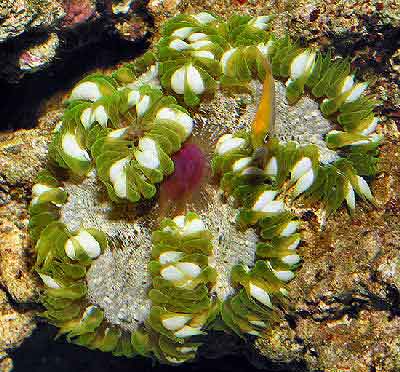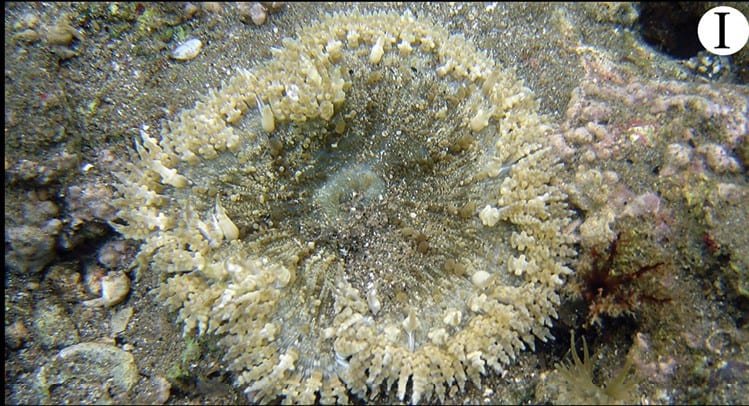
Very pretty, small, easy care, and inexpensive!… With a Red Beaded Anemone you’ve hit the jackpot!
The Red Beaded Anemone Phymanthus crucifer has all the desirable attributes of its relatives, and is one of the easiest anemones to care for. This is the best sea anemone for those who do not have the lighting, room, or experience needed for a “conventional” anemone. They only reach 4″, so are a good sized anemone for a nano tank. Plus being colorful and inexpensive makes this a fun and hardy choice for first time anemone keepers.
This anemone is also known as the Flower Anemone. It has a large oral disc with the tentacles around the edge. Because they are highly variable in both color and design, no two look the same. This is a sea anemone species that demonstrates morphologic variations in nearly every color of the rainbow. A wide variety of color morphs are available to aquarists from standard reds, oranges and purples, to bright exotic designer colors.
In nature, the Red Beaded Anemone can be found at depths of 10 to 98 feet (1 to 30 m). These Rock Anemones are often found on shaded vertical walls, where they adhere strongly to crevices in the rock. Or they are found buried in the sand with just their oral disk and tentacles showing, and their foot strongly adhered to hard surfaces under the sand. If they feel threatened or are disturbed, they will quickly retract and totally close. Being from a more shaded habitat, they don’t need the strong lighting that many sea anemones require.
For more about the types of Sea Anemone Species, see:
Sea Anemone – Tube Anemone
The Red Beaded Anemone is the perfect anemone for someone who has a nano tank or someone who does not have the light that is necessary for clown hosting anemones. This beautiful and compact anemone only reaches about 4″ and comes in a variety of colors. What sets it apart is that the tentacles have a “beaded” or segmented appearance. These anemones, unlike many of their cousins does NOT need a cold water aquarium! They are quite happy from 78 to 82˚F and they tend to stay put, which is great! Feed them 2 to 4 times a week with mysis and other meaty marine flesh.
- Minimum Tank Size: 5 gal (19 L)
- Aquarist Experience Level: Beginner
- Temperament: Semi-aggressive
- Temperature: 75.0 to 82.0° F (23.9 to 27.8° C)
- Size of organism – inches: 4.0 inches (10.16 cm)
- Diet Type: Carnivore
- Suitable for Nano Tank: Yes
Habitat: Distribution / Background
Sea Anemone Facts: The Red Beaded Anemone or Rock Flower Anemone Phymanthus crucifer was described by Le Sueur in 1817. The Phymanthus genus is a member of the Phymanthidae family. General common names this anemone is known by are Rock Anemone, Flower Anemone, Speckled Anemone, Banded Anemone, and Beaded Anemone. The Phymanthus crucifer is not on the IUCN Red List for endangered species.
There are 11 species in this genus. Besides the Red Beaded Anemone Phymanthus crucifer, there is: P. buitendijki, P. coeruleus, P. laevis, P. loligo, P. muscosus, P. pinnulatum, P. pulcher, P. rhizophorae, P. sansibaricus, and P. strandesi.
Where are Sea Anemones Found: The P. crucifer is found in the Western Atlantic Ocean in the caribbean.
Sea Anemone Habitat: They are found singly at depths of 10 – 98 feet (3 – 30m) on shaded vertical walls or buried in the sand with just their oral disk and tentacles showing. They adhere strongly into rock crevices or onto hard surfaces beneath sand, coral rubble, or pebble substrates. They use their venomous cells or nematocysts found in their tentacles to sting and deflect any possible threats or attacks.
- Scientific Name: Phymanthus crucifer
- IUCN Red List: NE – Not Evaluated or not listed
Description
Appearance of a Sea Anemone: The Rock Flower Anemone has a pedal column with a sticky foot that they use to adhere to various surfaces. The also use this “foot” to move around if conditions are not ideal. The color can be various shades of purples, browns, greens, oranges, reds, white, and cream.
Tentacles are on the margin or outside edge of the oral disc and have a “ribbed” or “beaded” appearance. These tentacles taper to a sharp tip and the oral disc can have small “bumps” the same color as the tentacles. The mouth is in the center and can be the same color as the oral disc, which is usually a different color than the tentacles, or a contrasting color. The mouth should be closed and tight, and will open when hungry, having an oval look. Yet a gaping mouth is a warning signal. The P. crucifer takes food in, and expels waste through this same opening.
Sea Anemones Life Cycles: Flower Anemones can grow up to 4″ (10 cm), but it is unknown how long they live. In fact some anemones can be hundreds of years old in the wild, and in captivity have been known to last 80 years or more.
- Size of organism – inches: 4.0 inches (10.16 cm)
- Lifespan: – It is unknown how long they live. Some anemones can be hundreds of years old in the wild, and in captivity have been known to last 80 years or more.
Difficulty of Care
Sea Anemone Care: The Red Beaded Anemone is one of the easiest anemones to care for. They are a small, hardy anemone with only a moderate lighting requirement. However, putting an anemone in a new tank will result in failure. The tank should be at least 4 months old and stable before adding your new P. crucifer anemone.
When choosing your Rock Flower Anemone, make sure the color is good, their mouth is not gaping open, and their foot and tentacles are sticky to the touch. Also, they should be attached to something and make sure there is no damage to the foot area, often a result of pulling the anemone off its surface.
To take a P. crucifer anemone from another aquarium, use a very thin blunt item like a credit card to get under the foot. Slowly nudging it away will help remove the anemone off the glass. If it’s attached to a rock, ideally you can simply purchase the rock as well. If you cannot purchase the rock then directing water at it or wiggling the rock gently upside down under water while tickling the foot can work.
- Aquarium Hardiness: Very Hardy
- Aquarist Experience Level: Beginner
Foods and Feeding
What Do Sea Anemones Eat: This anemone is a carnivore. Feed your Beaded Anemone chopped silversides, shrimp, krill, and mussels, fresh chopped fish (from your grocery store), as well as frozen carnivore preparations. They need food 2 to 4 times a week.
- Diet Type: Carnivore
- Meaty Food: All of Diet – They can be fed chopped silversides, shrimp, krill, and mussels, fresh chopped fish (from your grocery store), as well as frozen carnivore preparations.
- Feeding Frequency: Weekly – Feed them 2 to 4 times per week.
Aquarium Care
Water changes of 10% bi-monthly or 20% a month are typical. Monitor your water quality for your particular situation and adjust your water changes accordingly. Purigen and Poly-fiber are great products to help in maintaining water quality. Purigen is a synthetic polymer that removes soluble and insoluble impurities from water at an exceptionally high rate and capacity, helping to control ammonia, nitrites and nitrates. Additions of Iodine and and trace elements are suggested.
- Water Changes: Bi-weekly
- Iodine Levels: – Additions of Iodine and and trace elements are suggested.
Aquarium Setup
The typical reef environment is what is needed for your Red Beaded Anemone. Live rock and a sand/reef environment is typical of the Western Atlantic. They need live rock or some other solid material they can attach to. Be sure to have all of your pumps covered; most good quality pumps have guards on them and are worth the investment. Because this anemone will move about, you will want to provide foam filters over any power head intakes.
- Minimum Tank Size: 5 gal (19 L)
- Suitable for Nano Tank: Yes
- Live Rock Requirement: Typical Amount
- Substrate Type: Sand
- Lighting Needs: Low – subdued lighting – Low to Moderate.
- Temperature: 75.0 to 82.0° F (23.9 to 27.8° C)
- Specific gravity: 1.023-1.025 SG
- Water Movement: Moderate
- Water Region: Middle – Middle or bottom of the aquarium.
Social Behaviors
All anemones are semi-aggressive because they can be mobile, although a contented Rock Flower Anemone will stay put once it has found a place to settle. It has often been suggested to not put anemones in a reef environment because corals cannot move away from the stinging tentacles. Once you have your anemone situated and it has not moved for several months, it might be safe to add other corals. Keep this in mind when stocking sessile inverts.
After splitting, the Phymanthus genus will tolerate their own “clones” and their own species. If housing a different genus, they need to be at least 2-3 feet away from each other. Otherwise there will be “chemical” warfare with other species of anemones. This will usually cause one type of anemone to not eat, shrink, and eventually die.
- Venomous: Yes
- Temperament: Semi-aggressive
- Compatible with:
- Same species – conspecifics: Yes
- Anemones: Monitor
- Mushroom Anemones – Corallimorphs: Monitor
- Leather Corals: Monitor
- Stony Corals: May be aggressive
- Soft Corals: May be aggressive
Sex: Sexual differences
No sexual difference in appearance is known.
Breeding / Reproduction
The P. crucifer anemone is known to reproduce in captivity, but there is not much information on breeding these anemones. Anemones in general can multiply by sexual and asexual means. One way is using fission, which is when they actually split in half from the foot or mouth to form a clone, although the clone is its own animal, similar to twins. They will also reproduce using male and female sex glands or find another anemone of the opposite sex. This results in the production of ciliated planula larvae. This planula will eventually fall to the sea floor, develop a pedal disk, then begin to grow into a new anemone.
- Ease of Breeding: Moderate
Ailments / Diseases
Problems for the Red Beaded Anemone are pretty minimal unless your lighting, water movement, feeding, and water quality are low. Then your anemone will detach to look for “better conditions.” This usually results in an unpleasant experience with a water pump.
Availability
The Rock Flower Anemone P. crucifer is easy to find in stores and online and is inexpensive. The costs start at about $8.00 USD, and go up depending on size and color.
References
- Animal-World References: Marine and Reef
- Helmut Debelius and Hans A. Baensch, Marine Atlas Volume 1 (Baensch Marine Atlas), Microcosm Ltd, 1997
Phymanthus crucifer (Image Credit: Ricardo González-Muñoz, Nuno Simões, José Luis Tello-Musi, Estefanía Rodríguez, Wikimedia Commons CC BY-SA 3.0 Unported)
